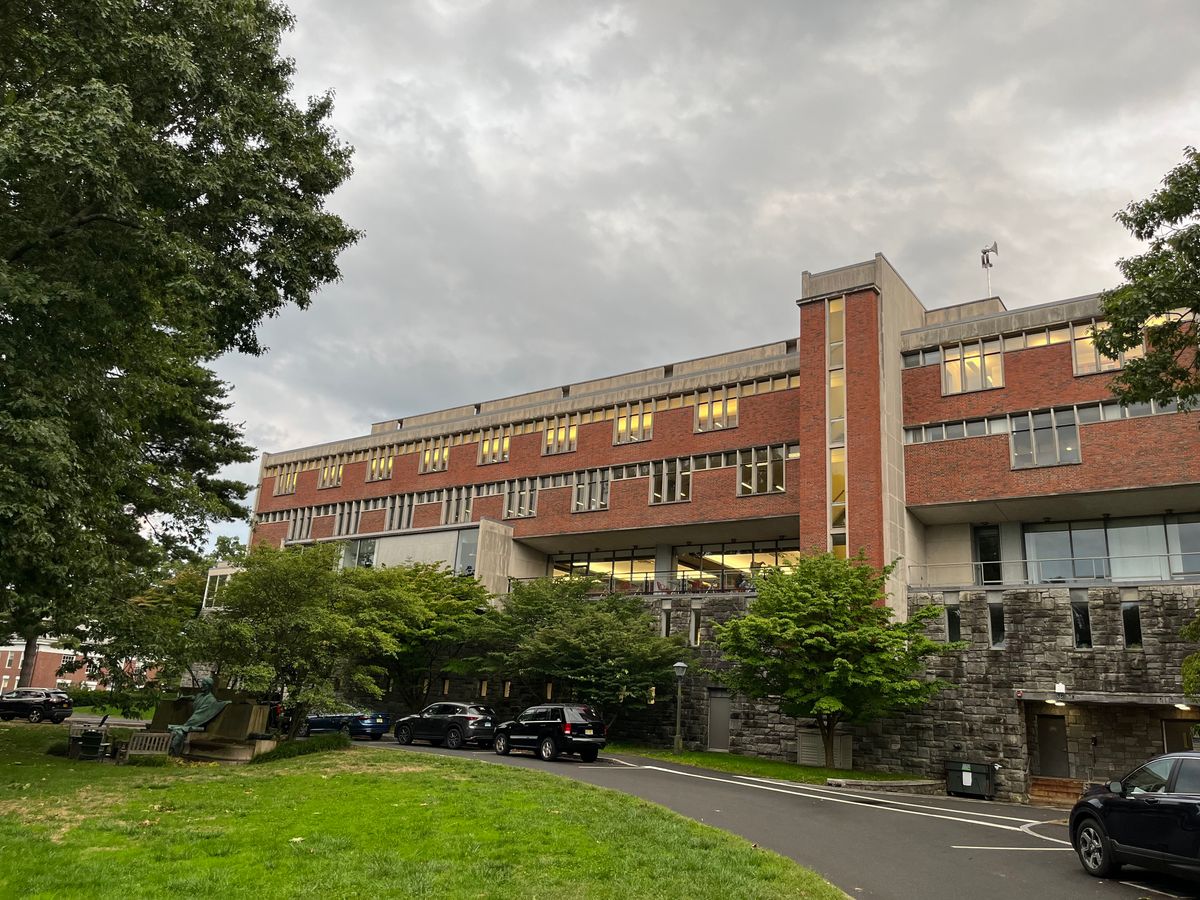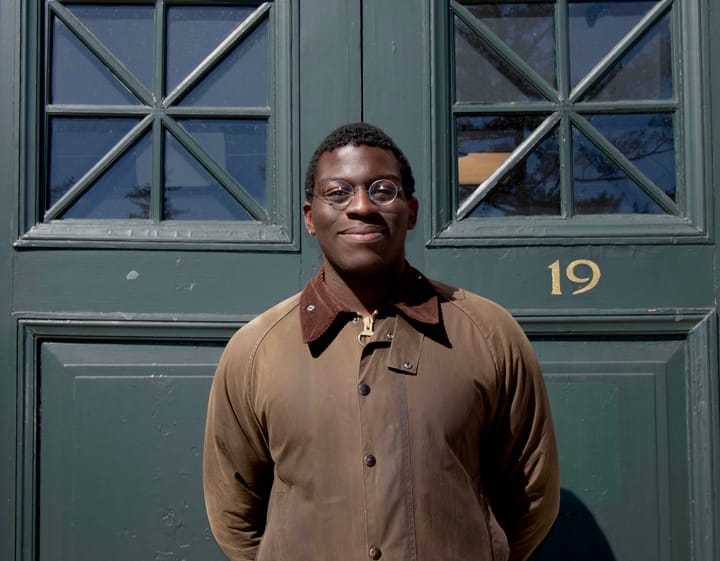The Brutalist Review: On the Building
Max Feigelson ’27 reviews “The Brutalist” (2024) and explores through it the relevance of the relationship between the life and work of artists. Feigelson discusses the background of brutalism, its importance for this “monumental” film, and our political challenges.

The last line of “The Brutalist” (2024) inverts a cliché. At a retrospective architectural biennale, László Tóth (Adrien Brody), is honored by his niece, Zsófia (played as an adult in this scene by Ariane Labed, and as a teenager by Raffey Cassidy). She ends her speech by quoting her uncle: “no matter what the others try and sell you, it is the destination, not the journey.”
The last line of “The Brutalist” is certainly not a summary of the entire film. Neither is “monumental,” the one word in quotes on the film’s poster. But when the end of the year comes around and we start seeing articles about the best films of the first quarter century topped by “Get Out” (2017), “Parasite” (2019), “In the Mood for Love” (2000), and “Moonlight” (2016) among others, “The Brutalist” will be listed among them, alongside a short description of its scope. And, with reference to its intermission and ambitious run-time, it will undoubtedly be described with that one word: “monumental.”
The word “monumental” is a pun referring to the film's form and its subject: architecture. Despite the potential double meaning of this word, this critic would argue that it’s best as a description of a subject; that despite the length of the film’s runtime, at its heart, “The Brutalist” is a small film.
I assure you that I mean no offense by the characterization. Neither do I mean to say that the film should’ve been any shorter than it is. I mean to say that one’s life and work are the most important things in the world, and doing justice to either of them in one film is already a miraculous achievement by writer-director Brady Corbet and writer Mona Fastvold.
“The Brutalist” is the story of László Tóth, a premier Hungarian-Jewish architect who survives the concentration camp at Buchenwald and emigrates to the United States, where a wealthy patron family, the Van Burens, employs him to construct a massive community center and Christian chapel. His family, which he manages to help escape a battered Europe, more visibly bears the scars of Nazi genocide which László seems to repress: his wife, Erzsébet (Felicity Jones), is paralyzed from the waist down due to famine-caused osteoporosis, and his niece, whom he and Erzsébet treat as a daughter since she was orphaned, is mute. Always at the heart of the story, though, is László and his work.
There will be a lot excluded from this review, including any mention of the film’s treatment of Judaism, rape, Zionism, heroin, philanthropy, xenophobia, and sex. This review is about architecture.
One of the risks of making a film about a fictional artist is that the product of that artist has to be good enough to justify the film. Whereas “A Complete Unknown” (2024) could coast on the already-proven success of Bob Dylan’s discography, “The Brutalist”'s production design team — led by soon-to-be Oscar winner Judy Becker — had to create original architecture and furniture that would justify the film’s emphasis on László’s virtuosity. It’s these inventions that elevate the film from merely a well-done period piece to a masterpiece. Although audiences seem to be primarily divided by their stances on brutalist aesthetics, my argument is that brutalism, and architecture generally, carries political importance beyond the binary trap of discussions in terms of “good/bad” and “like/don’t like.”
Much of the distaste for the aesthetic in American culture comes from a misunderstanding about the reason for the name “brutalism,” which sounds harsh and totalitarian in English, but actually has little to do with the adjective “brutal.” Instead, it comes from the French term “beton brut,” meaning “raw concrete.” Brutalism is not limited just to unfinished concrete (concrete that still bears the markings of the machinery involved in its first casting), but makes use of any material which has been left in its most natural state. Such a decision is controversial: László must defend the virtue of raw concrete and Italian carrara marble, materials which his uninspired American colleagues were taught to be inferior to their perfected alternatives.
There is no better counterargument than the film’s extended visit to the Italian marble quarries. We may think of marble perfection as deriving from its sanitized simplicity: The glossy depth of whiteness denoting purity and, in the case of government buildings, power. In the Italian quarries, owned and employed by anarchists who used the mines as their refuge and battleground against Mussolini, marble perfection is shown to be a product of imperfection. Each block contains blues, greys, and subtle yellows that point less to human virtues or strengths and more to deep, preternatural and geologic forces predating the anthropocene. The brutalist aesthetic, like that of omakase sushi, is achieved when the quality of these raw materials is presented in simple and striking forms.
This is what I love about brutalism. The style’s lack of elaborate ornamentation is fundamentally democratic and egalitarian, but unlike the plain blocks of Soviet and American public housing complexes, which seem to sacrifice form for function and doom themselves to utilitarian cynicism, well-done brutalism argues that buildings for common people are ultimately the material conditions necessary for a utopic future. I appreciate this style so much that when I grow tired of the quaintness of our New-England-townhouse-styled campus, which is beautiful but ultimately small, I’ll bike to the University of Massachusetts, Amherst just to be intimidated by its massive concrete, passageways, classroom buildings, and dormitories.
Unlike myself, who can only articulate his opinion about the style by being so pretentious as to call a building “utopic,” the film’s argument on behalf of its architecture is embedded in 20th-century political realities that aren’t necessarily named, but are certainly implied.
One of the more remarkable moments in the rise of Nazism was a 1937 state-sponsored exhibition of what Hitler and Goebbels termed “degenerate art.” Ironically, the Nazi attempt to exhibit that which they sought to mock as regressive “Jew art,” they mistakenly enframed an artistic canon now universally lauded. Among the artworks mocked are those of Pablo Picasso, Paul Klee, Marc Chagall, and Jean Metzinger.
This political background is largely implied — nobody in the film ever even mentions the Nazis — but when László’s patron, Harrison Van Buren (Guy Pearce), asks his architect how he came to choose his medium, László’s drive to build goes beyond aesthetic terms: “Nothing can be of its own explanation — is there a better description of a cube than that of its construction?”
All László can do is offer you the chance to encounter his work; to assume that beauty can be forced on its audience is to fall into the same trap as the Nazis. Instead, his motivation lies in politics: “There was a war going on, and yet it is my understanding that many of the sites of my projects have survived and are still there in the city. When the terrible recollections of what happened in Europe have ceased to humiliate us, I expect them to serve instead as a political stimulus, sparking the upheavals that so frequently occur in the cycles of peoplehood.”
Since the film's release, the validity of brutalist aesthetics has taken on another unanticipated political dimension. In his first hours in office, Trump signed an executive order entitled “Promoting Beautiful Federal Civic Architecture,” which aims to “advance the policy that federal public buildings should be visually identifiable as civic buildings and respect regional, traditional, and classical architectural heritage.” Vagueness of the imperative content of this “order” aside, Trump’s intervention represents another attempt by a proto-fascist state to craft an aesthetic identity around its nationalist ideology. This is small potatoes in comparison with Trump’s vow to round up undocumented immigrants and deport them, but the fact that the Trump administration made such a priority out of officially declaring an incongruity between a style of architecture and their larger ideology is telling about the importance of the medium.
The question of whether one likes the architecture of “The Brutalist” is bigger than preference. As a Jew myself, whose entire Feigelson bloodline was almost completely massacred in Latvia, it’s such an important question. I’m of the opinion that it borders on unethical not to engage with it. It’s okay not to like the brutalism of Marcel Breuer Ernő Goldfinger, Allison and Peter Smithson, or, finally, László Tóth. But the film’s argument is that one’s aesthetic perception and preference is no small matter; that it’s constantly threatened by the prevailing ideologies of the time; that one’s taste must not be made to take its place under the cliché that “art is subjective;” that the ability to feel strongly about a movie, building, or painting and to articulate one’s feelings is a key defense against fascism, which is always, always lurking. To end the conversation at “like/don’t like” is to give up.
The film sees László’s artistic integrity continually undermined by those too ignorant to appreciate the depth of his innovation. Even after he’s survived the Nazis, stupidity and ignorance — the roots of Nazism — are alive even in the country whose Statue of Liberty welcomed him. The story of his success is therefore anything but inevitable; it relies on a miraculous encounter between László and his benefactor. His talent isn’t immediately obvious to everyone; in fact the only people who are smart enough to truly recognize his talent are his family. Even the audience is left in the dark as to the true significance of László’s design choices; we learn in the epilogue that the dimensions of László’s building were designed to match those of the cell at Buchenwald and of his wife’s at Dachau, and that their connections through myriad corridors would allow the couple to never be separated again. This is the source of the political stimulus to which Brady Corbet’s script was referring.
László Tóth ends his artist’s statement with a prophecy, which, from Brady Corbet’s perspective, ends up as more of a description of contemporary times: “I already anticipate a communal rhetoric of anger and fear; a whole river of such frivolities may flow undammed, but my buildings were devised to endure such erosion of the Danube’s shoreline.” I’d recommend going over to UMass, not for the food but for the buildings. There is no Danube in America, but there is a Potomac.





Comments ()